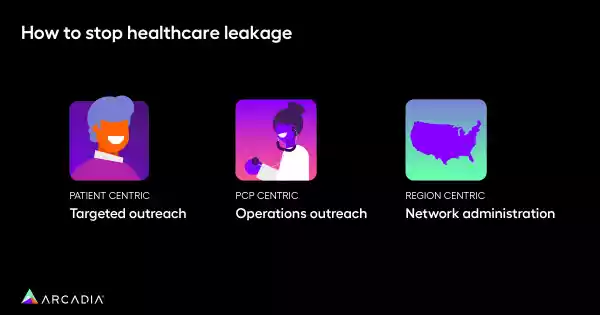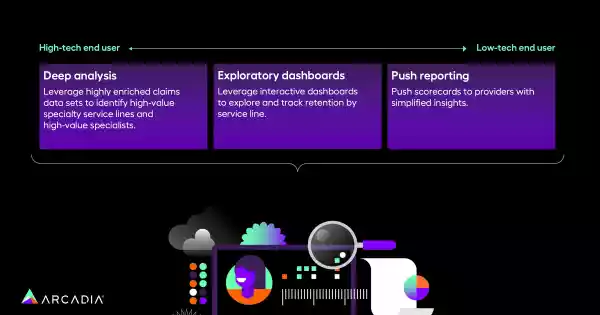Optimizing network utilization with data: A case study on how to prevent healthcare leakage
Leaks are never good. For healthcare organizations, leakage — when a patient seeks care from outside of its network of providers or facilities — is costly. In Arcadia’s Byte-Sized Insights, Jake Hochberg, Vice President of Data Analytics and Chief Analytics Officer at Arcadia, and David Leingang, Director of Program Analytics at Ochsner Health Network, reveal how they use data to optimize its network utilization with the support of a dynamic data platform.
In this article, we’ll cover the development of future insights-driven dashboards, methods Ochsner Health Network employs to analyze healthcare leakage, and how data is the key to optimizing network utilization.
What is leakage in healthcare?
Leakage in healthcare refers to patients who leave a healthcare provider’s network to seek care elsewhere. This leakage impacts both the continuity of care and the financial stability of healthcare organizations. When patients receive care outside of their primary network, it disrupts the coordination of care, leading to fragmented treatment plans, potential duplication of services, and ultimately, a decrease in the quality of patient care.
Patient leakage can be a significant financial burden for healthcare leaders. Revenue loss due to leakage can prevent an organization from investing in new technologies, expanding services, and improving patient care. Addressing this issue is crucial for maintaining a competitive edge, ensuring patient satisfaction, and achieving financial sustainability.
How to prevent leakage with healthcare dashboards

Most organizations today can use dashboards to show leakage reports. This requires users to filter those reports and pull the data they need out of the dashboard. As the amount of data increases and becomes more complex, users are becoming overwhelmed trying to sift through it all to identify the pieces they need to improve network utilization.
Organizations like Ochsner Health Network are working to simplify the user experience by turning those reports into recommendations; pushing out insights rather than requiring users to drill down through filters. This will save the users time and help them find solutions for leakage.
We’re trying to go toward recommended information; more insight-driven dashboards, pushing out information on leakage that they would have gotten to through a set of filters. Let’s use analytics and data science to produce that information for them.
By transitioning to insights-driven dashboards, healthcare organizations can proactively address patient leakage. These advanced dashboards not only present data but also provide actionable insights, helping organizations make informed decisions quickly.
While having advanced dashboards is critical, the effectiveness of these tools depends on the types of data in them. To streamline reports and enhance decision-making, organizations should focus on three key areas.
3 data-centric methods to stop healthcare leakage

Ochsner Health Network analyzes its data in three ways to help stop the leak: Patient-centric, PCP-centric, and region-centric. Categorizing data in these ways allows healthcare organizations to use it to identify and address issues in each area.
1. Patient-centric:
By examining data, organizations can understand which patients are leaving the network and target their outreach efforts accordingly. This approach helps identify why patients leave and allows the organization to attempt to bring them back if appropriate Additionally, it aids in improving the overall system to prevent future leakage by addressing the root causes of patient dissatisfaction.
2. PCP-centric:
By training and conducting outreach programs for primary care providers (PCPs), organizations can aim to keep patients within the network. Ochsner Health Network educates its doctors on methods and practices that encourage patient retention by helping them understand why some patients leave specific providers, ensuring that healthcare providers align with the organization’s goals and standards.
3. Region-centric:
By analyzing leakage data, organizations like Ochsner Health Network can identify areas where patients leave the network due to a lack of available services. This insight can lead to the strategic development of new clinics or specialties in regions where there is significant patient outflow. By addressing these service gaps, an organization can better meet the needs of its patient population and reduce leakage.
How a robust database can help plug the leak

1. Analysts:
A robust database should provide analysts with the tools for in-depth and comprehensive analysis. This includes a medical economics engine that groups together claims, offering a detailed view of service lines.
Analysts can see what services are in and out of the network and the preceding events that led to patient outflow. This helps build preferred service lines and provider networks, guiding physicians to focus on services and providers that keep care within the network. For example, steering a patient’s first visit to a dermatologist rather than a surgeon can significantly reduce downstream facility costs.
2. Non-Analyst Users:
An effective database should also offer exploratory dashboards that enable non-analyst users to explore trends and understand the dynamics of care within and outside the network. These dashboards help users identify which services and specialists are driving care in and out of the network, providing valuable insights without the need for advanced analytical skills.
3. Providers:
Push reporting capabilities are critical for providing actionable insights directly to providers. This includes information about which specialists patients see outside the network and potential high-quality alternatives within the network. Simplified reporting helps providers quickly see where their patients are going and identify redirection opportunities to keep care in-network.

At the end of the day, it’s analysts figuring out what to steer and where, and then giving providers more simplistic views of where their patients are going and redirection opportunities.
Keep more patients in-network
Optimizing network utilization is an essential element to every healthcare organization's financial well-being. By leveraging data to understand and address patient leakage, organizations can improve patient retention and overall care quality. Here are the key takeaways:
- Understand healthcare leakage: Recognize the financial and operational impacts of patients seeking care outside the network.
- Develop insights-driven dashboards: Utilize advanced dashboards to turn raw data into actionable insights.
- Implement data-driven strategies: Use patient-centric, PCP-centric, and region-centric approaches to reduce leakage and improve network retention.
- Utilize comprehensive databases: Adopt databases that provide deep analysis, exploratory dashboards, and push reporting to support various users within the healthcare organization.
Watch more Byte-Sized Insights or request a demo to learn how we can put your data to optimize network utilization, together.
